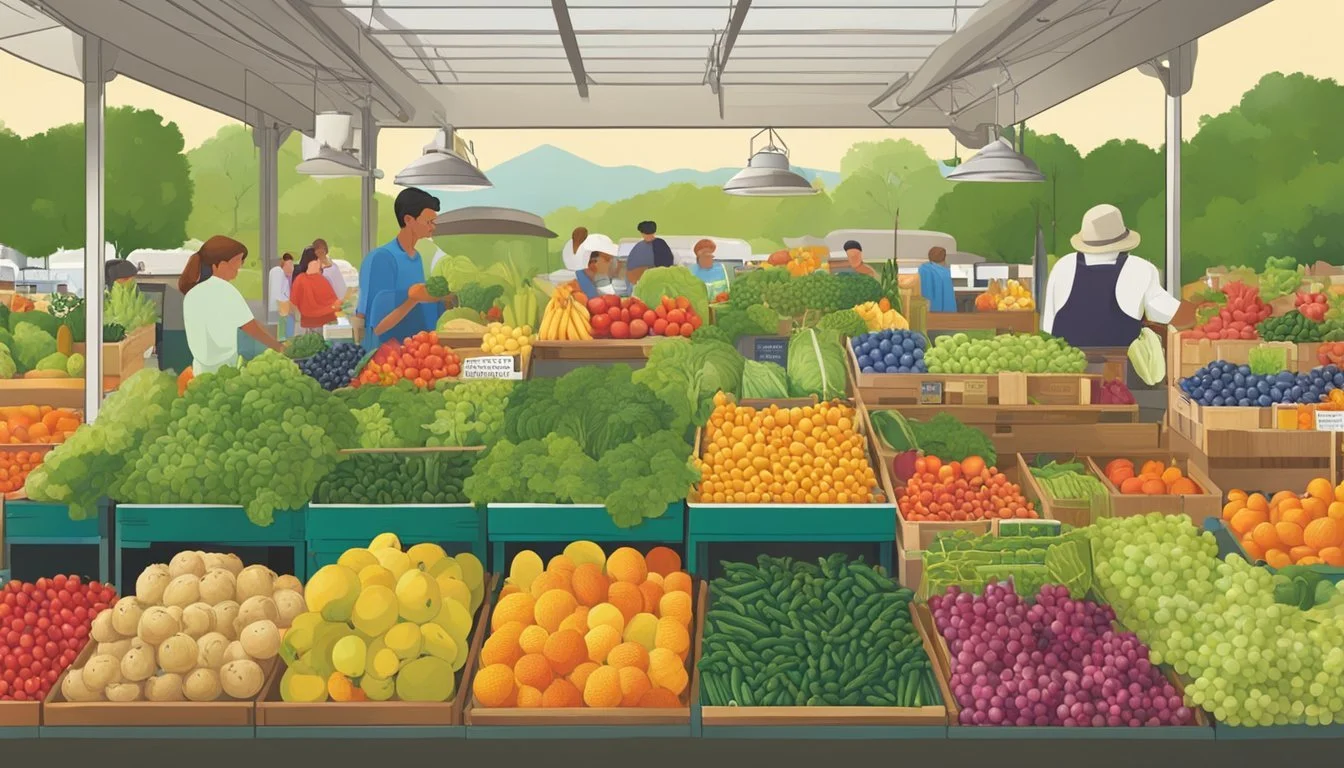Pennsylvania Seasonal Fruit & Vegetables in May
Your Fresh Picks Guide
This Article is Part of our Pennsylvania Seasonal Fruit & Veg Calendar
May in Pennsylvania heralds the arrival of a wide variety of fresh, local produce as spring temperatures encourage growth and ripening. During this month, farmers' markets and grocery stores begin to stock up on a bounty of fruits and vegetables that are in their prime. Asparagus (how long does asparagus last?) and arugula make an early appearance in the fields, while certain leafy greens thrive during this time, providing both flavor and nutrition.
Pennsylvania's climate and soil conditions in May are especially favorable for the cultivation of a range of root vegetables and delicate greens. Beets (how long do beets last?), known for their earthy taste and nutritional value, are among the vegetables that start to become available. The state's agricultural diversity is also evident in the appearance of various herbs, with basil beginning its season, infusing dishes with its aromatic presence.
As consumers prioritize fresh, local produce for its superior taste and nutrition, the seasonal offerings of Pennsylvania provide ample opportunity to enjoy a variety of fruits and vegetables at the peak of their freshness. Supporting local agriculture also has the added benefit of bolstering the regional economy and ensuring the availability of fresh, high-quality produce throughout the season.
Pennsylvania's Seasonal Cycles
As the spring weather takes hold, Pennsylvania's crop calendar enters a period of renewal and growth. This seasonal cycle is informed by a combination of specific regional weather patterns and the state's diverse agricultural practices.
Understanding the Seasonal Calendar
Pennsylvania's diverse climate, varying from the coastal plains in the southeast to the mountainous terrain in the north and west, impacts the growth cycles of local produce. Historically, farmers have leveraged a seasonal calendar to optimize the planting and harvesting of crops. This calendar is a guideline, shaped by traditional knowledge and modern meteorological data, to ensure produce is grown in its ideal conditions to maximize yield and quality. The relevance of the calendar centers around understanding what produce is best at specific times of the year.
May in Pennsylvania's Crop Calendar
By May, Pennsylvania's agriculture comes to life. Farmers and gardeners across the state are busy as spring's moderate temperatures and increased daylight hours create favorable conditions for a variety of fruits and vegetables.
Fruits:
Strawberries typically start in late May.
Vegetables:
Arugula (May through September)
Asparagus (May and June)
Beets (June through December) starting towards the end of May
Broccoli (June through November) seedlings planted in May for a later harvest
It's important to note that these are general timelines, and actual availability may change based on specific regional climates and current weather conditions. Farmers must adapt to these variables, often resulting in slight shifts in the crop availability calendar from year to year.
Fruit Highlights in May
May in Pennsylvania offers a delectable variety of fruits beginning to hit their peak ripeness. This prime time introduces some of the freshest and most flavorful produce of the season.
Strawberries & Blueberries
Strawberries in May make their sweet, red appearance known across Pennsylvania, favored for their bright flavor and versatility. They are ideal for an array of dishes, from salads to desserts.
Moving into the season, blueberries also start to emerge. Though typically reaching their peak a bit later in the summer, early varieties can be found gracing market stalls with their plump, juicy berries, hinting at the bounty to come.
Rhubarb Availability
May also marks the arrival of rhubarb, standing out with its tartness and vibrant red stalks. It is traditionally used in desserts and is especially renowned for its pairing with strawberries in pies and compotes, showcasing the season's fresh flavors.
With these fruits, shoppers can confidently indulge in the freshest tastes that Pennsylvania's May harvest has to offer, knowing they're experiencing these fruits in their prime season.
Vegetable Highlights in May
As May ushers in warmer temperatures across Pennsylvania, local gardens and markets come alive with a vibrant selection of vegetables. Consumers can enjoy peak flavor and variety, with an emphasis on leafy greens and earthy root vegetables enriched by the season's gentle rains.
Leafy Greens Variety
In May, Pennsylvania's vegetable bounty is led by leafy greens. Markets are typically full of:
Spinach: Known for its versatile use in salads and cooked dishes, spinach is at its tender best.
Lettuce: Various types are abundant, including crisp romaine and delicate butterhead varieties.
Kale: This nutritional powerhouse comes in several varieties, all offering a robust, slightly peppery flavor perfect for salads and sautés.
These greens are not only sought after for their freshness but also for their nutritional profiles, packed with vitamins and minerals.
Root Vegetables and Herbs
Root vegetables and fragrant herbs also make their mark in May:
Radishes: With a crisp texture and a peppery kick, radishes add a burst of flavor and color to dishes.
Turnips: These versatile roots can be enjoyed raw for their spicy bite or cooked to bring out a subtle sweetness.
Herbs freshly harvested in May, such as parsley, cilantro, and dill (how long does dill last?), provide an aromatic touch to meals, enhancing the natural flavors of other seasonal produce. All these vegetables are celebrated for their freshness and are often at their peak in flavor when grown and harvested in season within the state.
Local Markets and Availability
In May, Pennsylvania's local markets thrive with a plethora of seasonal fruits and vegetables, ensuring shoppers can enjoy the freshest produce from farm to table. Availability at farmers markets and supermarkets is abundant with offerings such as sweet corn and various in-season vegetables.
Farmers Markets Insights
Across Pennsylvania, farmers markets become vibrant spaces where locals can obtain fresh, in-season produce. Sweet corn, a seasonal favorite, generally starts to make its appearance at these markets towards the end of May, signaling the upcoming abundance of summer crops. Shoppers can typically find the following seasonal vegetables fresh off the farm:
Asparagus
Greens (e.g., spinach and lettuce)
Radishes
Spring onions
Aside from vegetables, early fruits such as strawberries start to dot market stalls, delighting shoppers with their freshness.
Supermarket Seasonal Stock
Supermarkets complement the fresh offerings of farmers markets by stocking an array of Pennsylvania-grown produce. During May, shelves are regularly replenished with these locally sourced vegetables:
In Season Vegetable Availability Note Asparagus Highly available Rhubarb Peaks in May Lettuce Varieties Consistently in stock Green Beans Beginning to appear
While supermarkets provide convenience, they also strive to support local farmers by highlighting Pennsylvania-sourced goods through various in-store promotions and signage.
Preparing Seasonal Produce
When May arrives, Pennsylvania's seasonal produce offers a bounty of fresh flavors that are both nutritious and delicious. These fruits and vegetables, at their peak season, bring vibrancy to dishes and menus. Harnessing their full potential necessitates proper preparation and preservation.
Cooking and Serving Suggestions
Asparagus: They should be lightly steamed or grilled to maintain their crisp texture. Asparagus can be a delightful side dish or a vibrant addition to a spring salad.
Arugula: This peppery green is best enjoyed fresh in salads or as a topping on pizzas and sandwiches for an added zing.
Beets: Roast beets to deepen their sweet flavor and serve them in salads or as a side.
Radishes: Slice them thinly and add to salads for a crisp, spicy note.
Preservation Techniques
Canning: Preserve the flavors of May by canning beets and radishes. Use pickling as a method to extend their shelf life and add a tangy twist to their natural flavors.
Freezing: Blanch vegetables like asparagus briefly before freezing them to preserve texture and color.
By employing these techniques, one ensures the longevity of Pennsylvania's seasonal produce and the possibility of savoring these flavors year-round.
Agricultural Practices
In the state of Pennsylvania, May marks a significant transitional period for crops and agricultural production. During this month, farmers employ a range of practices to ensure the sustainability and success of their seasonal harvests.
Sustainable Farming in Pennsylvania
Sustainable farming practices are pivotal to Pennsylvania's agricultural ethos, especially in the production of May's seasonal fruits and vegetables. Farmers across the state incorporate techniques that preserve the environment while providing fresh, local produce to consumers.
Crop Rotation: Farmers strategically rotate crops to manage soil fertility and reduce pest and disease problems, ensuring that produce such as strawberries, asparagus, and early greens flourish.
Integrated Pest Management (IPM): Producers employ IPM strategies to control pest populations with minimal environmental impact, which is crucial during the emergence of fruit-bearing plants in May.
Conservation Tillage: Reduced tillage methods help maintain soil structure and biodiversity. This is essential for crops sensitive to soil compaction and erosion.
Cover Crops: Utilizing cover crops during and after the main growing season enriches soil nutrients, suppresses weeds, and prevents soil erosion, contributing to the health of seasonal crops.
Water Management: Efficient irrigation systems and water conservation practices support the growth of thirsty crops while safeguarding against water wastage.
Through these and other sustainable practices, Pennsylvania's farmers contribute to a robust and eco-friendly agricultural sector, ensuring that May's bounty is bountiful and sustainably harvested.








